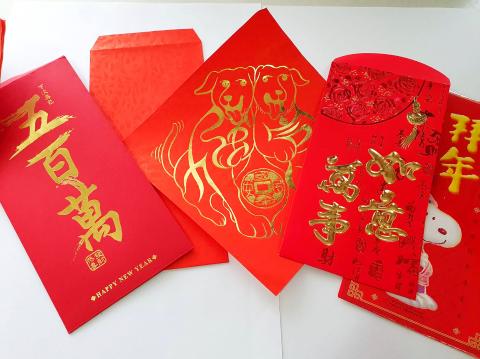Materials used to make hongbao (紅包, a red envelope containing money) and chunlian (春聯, a spring couplet) might contain toxic chemicals, so people should wash their hands thoroughly to ensure that no residues remain, a doctor said.
It is a popular tradition in Taiwan to hand out hongbao and decorate homes with spring couplets as part of the Lunar New Year celebrations.
However, the synthetic dyes used to make red envelopes and spring couplets could cause allergic reactions in children, as well as release volatile organic compounds that contain formaldehyde, a carcinogen, En Chu Kong Hospital Nephrology Division director Lin Chien-yu (林建宇) said, adding that the gilding on red envelopes could contain heavy metals.

Photo: Chiu Shu-yu, Taipei Times
Chemical compounds that disrupt hormonal activity are known as environmental hormones, with 70 to 80 different types currently known in the medical field, such as plasticizers, bisphenol A and dioxins, he said.
These environmental hormones have been detected in food-wrapping bags, yoga mats, waterproof fabric Gore-tex, toys and stationery, and although some substances only have a short life in the human body, long-term exposure could still cause health hazards.
Most environmental hormones accumulate easily in fatty tissue, or around skin and viscera, posing a risk to consumers, he said.
Although animal experiments have revealed that certain chemical compounds cause cancer in animals, medical proof that they cause cancer in humans is still lacking, Lin said.
Nonetheless, research has concluded that prolonged exposure to such chemicals could lead to a low sperm count and smaller penis in boys, while sexual precocity could occur in girls, Lin said.
Pregnant women exposed to such chemicals could give birth to babies with stunted development, he said.
“Environmental hormones also play a part in diseases common in older people, such as age-related atherosclerosis, hypertension, liver problems and abnormal glucose metabolism,” Lin said.
To avoid storing environmental hormones in body, people should incorporate a variety of food in their diet to ensure a balanced nutrition, he added.

Taiwanese scientists have engineered plants that can capture about 50 percent more carbon dioxide and produce more than twice as many seeds as unmodified plants, a breakthrough they hope could one day help mitigate global warming and grow more food staples such as rice. If applied to major food crops, the new system could cut carbon emissions and raise yields “without additional equipment or labor costs,” Academia Sinica researcher and lead author the study Lu Kuan-jen (呂冠箴) said. Academia Sinica president James Liao (廖俊智) said that as humans emit 9.6 billion tonnes of carbon dioxide compared with the 220 billion tonnes absorbed

The Taipei Mass Rapid Transit (MRT) Wanda-Zhonghe Line is 81.7 percent complete, with public opening targeted for the end of 2027, New Taipei City Mayor Hou You-yi (侯友宜) said today. Surrounding roads are to be open to the public by the end of next year, Hou said during an inspection of construction progress. The 9.5km line, featuring nine underground stations and one depot, is expected to connect Chiang Kai-shek Memorial Hall Station to Chukuang Station in New Taipei City’s Jhonghe District (中和). All 18 tunnels for the line are complete, while the main structures of the stations and depot are mostly finished, he

Taipei is to implement widespread road closures around Taipei 101 on Friday to make way for large crowds during the Double Ten National Day celebration, the Taipei Department of Transportation said. A four-minute fireworks display is to be launched from the skyscraper, along with a performance by 500 drones flying in formation above the nearby Nanshan A21 site, starting at 10pm. Vehicle restrictions would occur in phases, they said. From 5pm to 9pm, inner lanes of Songshou Road between Taipei City Hall and Taipei 101 are to be closed, with only the outer lanes remaining open. Between 9pm and 9:40pm, the section is

China’s plan to deploy a new hypersonic ballistic missile at a Chinese People’s Liberation Army Rocket Force (PLARF) base near Taiwan likely targets US airbases and ships in the western Pacific, but it would also present new threats to Taiwan, defense experts said. The New York Times — citing a US Department of Defense report from last year on China’s military power — on Monday reported in an article titled “The missiles threatening Taiwan” that China has stockpiled 3,500 missiles, 1.5 times more than four years earlier. Although it is unclear how many of those missiles were targeting Taiwan, the newspaper reported